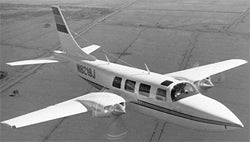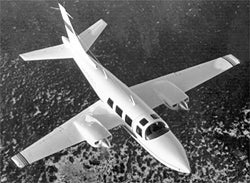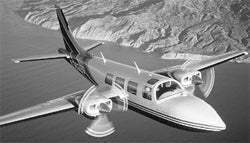 Piper Aerostar 600A | STANDARD DATA: 600A) Seats 6. Gross wt. 5,500. Empty wt. 3,735. Fuel capacity 165. Engines two 290-hp Lycomings. PERFORMANCE: Top mph 260.02-Multi-Cruise mph 253. Stall mph 85. Initial climb rate1,800. Range 1,131. Ceiling 21,200. Takeoff distance (50') 1,950. Landing distance (50') 1,840. STANDARD DATA: (601B) Seats 6. Gross wt. 6,000. Empty wt. 3,958. Fuel capacity 165. Engines two 290-hp turbo-charged Lycomings. STANDARD DATA: (601P) Seats 6. Gross wt. 6,000. Empty wt. 4,056. Fuel capacity 165. Engines two 290-hp Lycomings. STANDARD DATA: (700 P) Seats 6. Gross wt. 6,315. Empty wt. 4,275. Fuel capacity 165-210. Engines two 350-hp Lycoming TIO-540-U2A. |
 Piper Aerostar 601B | |
 Piper Aerostar 700P |
The Aerostar is another outstanding design by Ted Smith. Originally built by the Ted Smith Aircraft Co. (a subsidiary of the American Cement Corp.), production began in 1967 on a limited basis. In 1969, the assets of the company were purchased by Butler Aviation International, which also acquired Mooney Aircraft Corp. one year later. The Aerostars built under this management were referred to as Aerostar Mooneys, but the project was soon suspended. In 1972 Ted R. Smith and Associates Inc. was formed, and production of the Aerostar executive transport resumed.
The Model 600 is powered by two 290-hp six-cylinder normally aspirated engines. Its basic structure consists of innovations to reduce weight and improve strength. The airframe contains only half as many components as that of many other comparable aircraft. Also, the Aerostar components are interchangeable with those of other sister ships. The Model 601 is the turbocharged version, and the 601P features pressurization. A slightly larger and more powerful development is designated the Aerostar 700 and is powered by two 350-hp Lycomings. Its speed is increased to 275 mph at sea level and its gross weight is boosted to 6,300 pounds. The latest 601B features wings extended 15 inches on each side to result in an increased gross weight, which has, in turn, boosted useful load by about 270 pounds.
Piper took over production of the Aerostars in 1979. The fastest Aerostar also has the distinction of being the fastest six-place general aviation piston twin in the world: the 601B. All three Piper Aerostars can attribute their performance to a sleek aerodynamically advanced design that features a radically aft-swept horizontal stabilizer, reduced and swept vertical stabilizer, mid-fuselage wings with trailing-edge taper, and an elongated pointed nose. Purchasing the Aerostars was a quick way for Piper to expand its twin lineup and fill the gap between the 250-hp Aztec and the 310- to 425-hp Navajos. For 1981, the Aerostar 601B and 601P were approved for flight into icing conditions to enhance their usefulness to corporate, commuter, and airtaxi
operations.
The final version of the Aerostar, the model 700P, added more powerful engines, 350-hp turbocharged and counter rotating TIO540U2As, and an option for additional fuel. The 700P also had a higher takeoff weight. Only 25 of what many consider the best of the Aerostars were ever produced before Piper took the twin out of production.

Subscribe to Our Newsletter
Get the latest Plane & Pilot Magazine stories delivered directly to your inbox





